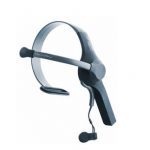Osso VR is a validated virtual reality surgical training platform designed for surgeons, sales teams, and hospital staff of all skill levels. The product offers highly realistic hand-based interactions in immersive training environments that contain the latest, cutting edge procedures and technology.
Osso VR offers highly realistic hand-based interactions in immersive training environments that contain the latest, cutting edge procedures and technology
Educating surgeons is progressively becoming more difficult due to a phenomenon called the ‘training gap’. This gap is the result of the procedures that need to be learned becoming more complex and also more numerous – while due to work hour restrictions and other factors like electronic medical record systems – the time we have to learn them is reducing. The result is that an ever-increasing percentage of surgeons graduates from their training either feeling or being rated as unable to operate independently.
This is especially an issue when it comes to learning to use newer medical technology. Typically a surgeon will learn about a new device at a one day “course,” and then be expected to use that device on a patient. Unfortunately, there is a course-to-case gap of often 4-6 months before the surgeon actually uses the device in the operating room. This leads to a much higher complication rate and limits adoption of newer and more effective medical technology.
Virtual Reality (VR) has the ability to transport the medical personnel inside the human body – to access & view areas that otherwise would be impossible to reach. Currently, medical students learn on cadavers, which are difficult to get hold of and (obviously) do not react in the same way a live patient would. In VR however, it is possible to view minute detail of any part of the body in stunning 360° CGI reconstruction & create training scenarios which replicate common surgical procedures.
The global market for Virtual Reality in healthcare is projected to reach US$3.8 billion by 2020, driven by technology advancements in healthcare IT, expanding applications into diverse medical disciplines, and increasing demand for rehabilitation and simulation training. VR technology continues to gain visibility as a potent diagnostic tool in the form of fully immersive 3D simulation for clinicians in the treatment of phobias, autism, post-traumatic stress disorder (PTSD), depression, anxiety and severe pain in burn victims. The US represent the largest market worldwide. Strong R&D increased investments in VR technology by the government and private companies and the large base of early adopters are major factors supporting the country’s dominance. Asia-Pacific is projected to emerge as the fastest growing market with a CACR of 23.2 per cent over the analysis period, led by developing healthcare infrastructure and strong appetite for innovative medical technologies capable of lowering healthcare costs, adding economic and societal value and enabling patients lead healthier and higher-quality lives.
Osso VR is a validated virtual reality surgical training platform designed for surgeons, sales teams, and hospital staff of all skill levels. The product offers highly realistic hand-based interactions in immersive training environments that contain the latest, cutting edge procedures and technology.
 The MediWorld ME team met with the Co-Founder/ CEO Justin Barad, MD to discuss how Osso VR is currently focused on solving training gaps for orthopaedic and spine therapies, and how it is also expanding into other specialties and procedures.
The MediWorld ME team met with the Co-Founder/ CEO Justin Barad, MD to discuss how Osso VR is currently focused on solving training gaps for orthopaedic and spine therapies, and how it is also expanding into other specialties and procedures.
Surgical simulation platform
As technology continues to advance, the need for newer and more specialized forms of training continues to rise. But there are no resources available to teach surgeons both the new and existing ways of doing things. The result is that most surgeons aren’t getting enough training and it increases risks for patients every time they’re on the operating table.
Osso VR is a clinically validated, award winning surgical simulation platform that can be used anytime and anywhere to practice medical procedures in a hands-on way.
“Osso VR’s modules are designed with the needs of users of various levels and roles. For example, a junior resident may want to focus on the basic steps of a procedure while an expert surgeon years into practice may want to focus on how to handle complications and rare events”, Barad notes.
Technology used
Osso uses virtual reality to enable surgeons to perform realistic orthopaedic surgery, replacing an old, complicated, expensive manual simulation created by the aptly named Sawbones Corp. Sawbones provides a realistic moulded plastic model of the bone for orthopaedic training and practice. The models are expensive and can only be used once.
Much of Osso VR’s business comes from medical device manufacturers, who now have a way to show surgeons the benefit of the new implants and techniques while training them in their use. Studies show surgeons who train with Osso’s system achieve test results twice as good as good as those trained using current methods. Osso VR works with most high-end consumer VR technology such as the Oculus Rift and HTC Vive.
Osso VR is built on Unity game engine; you probably wouldn’t consider the graphics to be super photorealistic. Dr. Barad explains that the purpose of Osso VR is not to train with minute precision; it is to get users comfortable with the sequence of events in a surgical procedure and to train them how to use the different tools and devices.
“As users continues to train with the software, these steps eventually become muscle memory, allowing them to focus more on precision and technique when it comes time to operate on live patients. Dr. Barad also warns that overly realistic graphics could have unintended negative consequences with the ‘uncanny valley” phenomenon.
Immersive training environment
The typical training process for surgeons largely consists of low-tech instruction manuals and videos, and often involves traveling to one-day surgical training courses. On occasion, there might be a single brief training procedure on a cadaver. It is often many months later that the surgeon is thrown into the operating room to perform the newly learned technique on real patients without having had any real practice. It’s no wonder that residents can become so uneasy during their first live surgeries, and patients consequently can be averse to being operated on in teaching hospitals or treated with new surgical techniques, tells Dr. Barad.
With Osso VR, orthopedic surgeons can not only freely look and move around their environment with a VR headset, but the hand controllers allow them to hold and manipulate tools and devices in the right sequence and ‘operate’ on a patient’s leg with accurate and precise movements. Osso VR makes the experience as accurate as possible and grades your performance based on time, accuracy, and other metrics that surgeons are typically evaluated on.
“The immersive VR headset allows you to transport yourself into a virtual operating room where you can then practice whatever procedure is desired. Our advanced interaction system allows for intuitive and realistic movements that in clinical studies have been proven to translate to real world skill transfer”.
Osso VR is designed to improve patient outcomes: “We do not claim on the website that Osso VR itself will save the lives of patients in any given scenario, however, we are working to both make and prove that Osso VR will improve patient outcomes.”
Training medical staff
Typically newer medical technology provides more value, which means it improves patient outcomes, decreases costs to the system or both. By increasing the adoption of newer medical technology outcomes for patients are improved and this allows more patients to be treated by conserving healthcare dollars spent.
“The training gap is only getting worse and is unlikely to improve. We need to change the way we learn about new medical technology in order to adapt to the new level of complexity in surgery and medical devices that is rapidly becoming the standard.
“We capture all data and metrics from run throughs that through our analytics engine is visualized in an easy to understand way that can provide actionable information to improve trainee, and even trainer, performance,” adds Dr Barad.
Surgical training has not changed significantly in over a 100 years.
“We have proven that Osso VR is clinically effective and is a valuable and effective solution for the growing training crisis in the surgical field. We are currently focused on surgical training but this includes most users associated with the procedure including surgical techs, sales reps, circulator nurses, surgeons and assistants.
“Yes, we are constantly upgrading the platform and increasing the quality in addition to performing constant validation that it is actually leading to skill transfer and are already in talks with various regions outside the US to make our technology available on a global level. Stay tuned,” concludes Dr Barad.
















